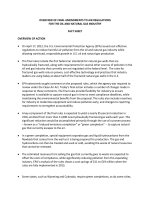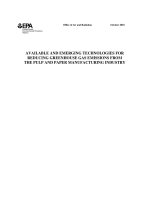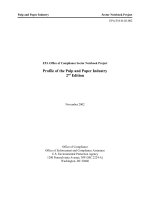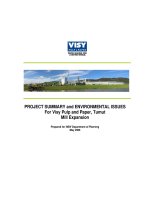Steam System Opportunity Assessment for the Pulp and Paper, Chemical Manufacturing, and Petroleum Refining Industries pptx
Bạn đang xem bản rút gọn của tài liệu. Xem và tải ngay bản đầy đủ của tài liệu tại đây (1.31 MB, 102 trang )
T
O
F
E
N
E
R
G
Y
D
E
P
A
R
T
M
E
N
U
E
N
I
T
E
D
S
T
A
T
S
O
F
A
E
R
I
C
A
M
Office of Energy Efficency and Renewable Energy
U.S. Department of Energy
Steam System
Opportunity
Assessment
for the
Pulp and Paper,
Chemical
Manufacturing,
and Petroleum Refining
Industries
Steam System
Opportunity
Assessment
for the
Pulp and Paper,
Chemical
Manufacturing,
and Petroleum Refining
Industries
Main Report
Main Report
Download
CD-ROM
Zip File
(27.3 MB)
Steam System
Opportunity
Assessment
for the
Pulp and Paper,
Chemical
Manufacturing,
and Petroleum Refining
Industries
Steam System
Opportunity
Assessment
for the
Pulp and Paper,
Chemical
Manufacturing,
and Petroleum Refining
Industries
Main Report
Main Report
ii
Steam System Opportunity Assessment for the Pulp and Paper,
Resource Dynamics Corporation prepared this report for the U.S. Department of Energy’s
Office of Industrial Technologies. Several individuals provided significant assistance in gath-
ering, interpreting, and presenting the data for this report. Specific thanks are extended to:
Dr. Anthony L. Wright, Oak Ridge National Laboratory, technical support BestPractices Steam,
project manager
Fred Hart, U.S. Department of Energy, Office of Industrial Technologies, BestPractices Steam,
program manager
Richard Counts, Oak Ridge National Laboratory, statistical analysis and support
Christopher Russell, Alliance to Save Energy, BestPractices Steam support
Throughout the development of this report, technical review and guidance was provided by
the BestPractices Steam program. Appreciation is extended for the assistance provided by the
following committees:
BestPractices Steam Steering Committee
BestPractices Steam Marketing and Communications Subcommittee
BestPractices Steam Technical Subcommittee
BestPractices Steam Policy and Metrics Subcommittee
Resource Dynamics Corporation would also like to thank the industry experts who provided
valuable data regarding the potential energy savings estimates:
Richard Crain, III, P.E., Parker, Messana, & Associates Management Institute
Robert Dawson, P.E., Dawson Engineering
Dr. Herb Eckerlin, North Carolina State University
Dr. Ahmad Ganji, San Francisco State University
Robert Griffin, Enbridge Consumers Gas, Canada
Glenn Hahn, Spirax Sarco, Inc.
Greg Harrell, P.E., Ph.D., Energy, Environment and Resources Center, University of Tennessee-Knoxville
Derek Hengeveld, South Dakota State University
Kenneth Heselton, KEH Energy Engineering
Nevena Iordanova, CEM, Armstrong Service
Dr. Richard Jendrucko, University of Tennessee-Knoxville
Walter Johnston, P.E.
Dr. Beka Kosanovic, University of Massachusetts-Amherst
James Kumana P.E., Kumana and Associates
Andrew W. Larkin, P.E., CEM, Trigen-Philadelphia Energy Corporation
Kelly Paffel, P.E., Plant Support and Evaluations, Inc.
John Puskar, P.E., CEC Consultants
Charles G. Turner, Charles G. Turner & Associates
Paul Wilson, P.E., Engineered Solutions
Donald Wulfinghoff, P.E. Wulfinghoff Energy Services, Inc.
Resource Dynamics Corporation also acknowledges technical assistance made by the following:
Gary Bases, BRIL Inc.
Bruce Gorelick, Enercheck Systems Inc.
Mike Sanders, Sunoco Corporation
John Todd, Yarway Corporation
Kevin Hedgers, Energy Saving Audits, Inc.
iii
Chemical Manufacturing, and Petroleum Refining Industries
Acknowledgements
Acknowledgements
iv
Steam System Opportunity Assessment for the Pulp and Paper,
v
Chemical Manufacturing, and Petroleum Refining Industries
Table of Contents
Table of Contents
Main Report
Acknowledgements . . . . . . . . . . . . . . . . . . . . . . . . . . . . . . . . . . . . . . .iii
Table of Contents . . . . . . . . . . . . . . . . . . . . . . . . . . . . . . . . . . . . . . . . .v
List of Figures and Tables . . . . . . . . . . . . . . . . . . . . . . . . . . . . . . . . . .vii
Abstract . . . . . . . . . . . . . . . . . . . . . . . . . . . . . . . . . . . . . . . . . . . . . . .xi
1. Executive Summary . . . . . . . . . . . . . . . . . . . . . . . . . . . . . . . . . . . . .1
2. Steam Generation in the Pulp and Paper,
Chemical Manufacturing, and Petroleum Refining Industries . . . . . . . . .11
3. Steam Use in the Pulp and Paper,
Chemical Manufacturing, and Petroleum Refining Industries . . . . . . . . .23
3.1 Assessing Steam Use in the Pulp and Paper Industry . . . . . . . . . . . . . . . .24
3.2 Assessing Steam Use in the Chemical Manufacturing Industry . . . . . . . . .37
3.3 Assessing Steam Use in the Petroleum Refining Industry . . . . . . . . . . . . .52
4. Steam System Performance Improvement Opportunities . . . . . . . . . . . .67
Appendices
The appendices can be found on a CD-ROM attached to this report or online at
www.oit.gov/bestpractices.
Appendix A: MECS Data for the Pulp and Paper, Chemical Manufacturing, and
Petroleum Refining Industries . . . . . . . . . . . . . . . . . . . . . . . . . .Apx-1
Appendix B: Discussion of Assumptions Used in Assessing Energy Data in
the Pulp and Paper, Chemical Manufacturing, and Petroleum
Refining Industries . . . . . . . . . . . . . . . . . . . . . . . . . . . . . . . .Apx-11
Appendix C: Steam System Performance Improvement Opportunity Descriptions . . .Apx-17
Appendix D: Steam System Performance Improvement Opportunity
Questionnaire Description . . . . . . . . . . . . . . . . . . . . . . . . . . .Apx-23
Appendix E: Steam System Performance Improvement Opportunity Data Tables . . .Apx-37
Appendix F: Analysis of Expert Responses to the Steam System Improvement
Opportunities Questionnaire . . . . . . . . . . . . . . . . . . . . . . . . . .Apx-55
Appendix G: Reasons for Implementing Steam System Performance
Improvement Opportunities . . . . . . . . . . . . . . . . . . . . . . . . . . .Apx-63
Appendix H: Recommendations for Assessing the Effectiveness of the
BestPractices Steam Program . . . . . . . . . . . . . . . . . . . . . . . . .Apx-67
vi
Steam System Opportunity Assessment for the Pulp and Paper,
Section 1—Executive Summary
Figure ES-1. Estimated Steam Energy Use for Major Pulp and Paper Products
Figure ES-2. Estimated Steam Energy Use for 20 Major Chemical Products
Figure ES-3. Estimated Steam Energy Use for Major Petroleum Refining Processes
Figure ES-4. Total Industry Fuel Savings for each Part of the Steam System
Table ES-1. Total Potential Steam System Energy Savings by Industry
Section 2
Table 2-1. Example of Inferring Missing Data in MECS
Table 2-2. Estimated Amount of Fuel Used to Generate Steam by Industry
Table 2-3. Estimated Amount of Steam Generated From Fuel by Industry
Table 2-4. Estimated Amount of Purchased Steam by Industry
Table 2-5. Estimated Total Steam Available to the Target Industry Segments
Table 2-6. Purchased Steam as a Percentage of Total Available Steam by Industry
Table 2-7. Cost of Steam by Industry
Table 2-8. Steam Energy as a Percentage of Total Energy by Industry
Section 3
3.1—Pulp and Paper Industry
Figure 3.1-1. Estimated Steam Energy Use for Major Pulp and Paper Products
Figure 3.1-2. Pulp and Paper Industry Boiler Capacity by Fuel Type
Figure 3.1-3. Pulp and Paper Industry Steam System Capacity by Pressure
Figure 3.1-4. Pulp and Paper Industry Boiler Size Distribution
Table 3.1-1. Energy Use at Integrated Pulp and Paper Mills
Table 3.1-2. Relating Major Pulp and Paper Product to Integrated Plant Type
Table 3.1-3. Pulp and Paper Production Data and Associated Energy Use
Table 3.1-4. Thermal Energy Requirements of Kraft Pulping
Table 3.1-5. Thermal Energy Requirements of Sulfite Pulping
vii
Chemical Manufacturing, and Petroleum Refining Industries
List of Figures and Tables
List of Figures and Tables
Table 3.1-6. Energy Requirements of Selected Mechanical Pulping Processes
Table 3.1-7. Other Pulp and Paper Process Thermal Energy Requirements
Table 3.1-8. Bleaching and Drying Energy Requirements for Mechanical Pulping
Table 3.1-9. Thermal Energy Requirements for Papermaking
Table 3.1-10.Energy Use by Cogeneration Technology
3.2—Chemical Industry
Figure 3.2-1. Estimated Steam Energy Use for 20 Major Chemical Products
Figure 3.2-2. Chemical Industry Boiler Capacity by Boiler Size
Figure 3.2-3. Chemical Industry Boiler Capacity by Fuel Type
Figure 3.2-4. Chemical Industry Steam System Capacity by Pressure
Figure 3.2-5. Cogeneration Fuel Use in the Chemical Industry
Table 3.2-1. Leading Energy-Intensive Chemicals
Table 3.2-2. Energy Use in Ethylene Production
Table 3.2-3. Energy Use in Ammonia Production
Table 3.2-4. Energy Use in Urea Production
Table 3.2-5. Energy Use in Ethylbenzene/Styrene Production
Table 3.2-6. Energy Use in Polystyrene Production
Table 3.2-7. Energy Use in Chlorine/Sodium Hydroxide Production
Table 3.2-8. Energy Use in Ethylene Dichloride/PVC Production
Table 3.2-9. Energy Use in Phenol/Acetone Production
Table 3.2-10.Energy Use in Benzene, Toluene, and Xylene Production
Table 3.2-11.Energy Use in Caprolactum Production
Table 3.2-12.Energy Use in Sodium Carbonate Production
Table 3.2-13.Energy Use in Polybutadiene Rubber Production
Table 3.2-14.Energy use in Styrene Butadiene Rubber Production
Table 3.2-15.Energy Use in Butyl Rubber Production
Table 3.2-16.Energy Use in Cyclohexane Production
3.3—Petroleum Industry
Figure 3.3-1. Estimated Steam Energy Use for Major Petroleum Refining Processes
Figure 3.3-2. Basic Process Flow of a Petroleum Refinery
Figure 3.3-3. Boiler Capacity in the Petroleum Industry by Boiler Size
viii
Steam System Opportunity Assessment for the Pulp and Paper,
Figure 3.3-4. Petroleum Industry Boiler Capacity by Fuel Type
Figure 3.3-5. Petroleum Industry Steam System Capacity by Pressure
Table 3.3-1. Energy Requirements of Common Refinery Processes
Table 3.3-2. Estimated Steam Generation Capacity by Cogeneration in the
Petroleum Industry (MMBtu/hr)
Section 4
Figure 4-1. Total Industry Fuel Savings for Each Part of the Steam System
Figure 4-2. The Majority of General Opportunity Fuel Savings Were Greater Than 1 Percent
Figure 4-3. Facilities Where General Opportunities are Feasible Ranged from
3 to 29 Percent.
Figure 4-4. Simple Paybacks for Steam System Improvements Were Reported to be
Typically Less Than 2 Years
Figure 4-5. Total Fuel Savings for General Steam Improvement is About 4 Percent.
Figure 4-6. Typical Industry Fuel Savings for Each Major Area of the Steam System
Figure 4-7. Total Industry Fuel Savings for Each Part of the Steam System
Table 4-1. Total Potential Steam System Energy Savings by Industry
Table 4-2. General Opportunity Fuel Savings
Table 4-3. Percentage of Facilities Where the General Opportunities are Feasible
Table 4-4. Payback Period by Opportunity
Table 4-5. Industry Fuel Savings by General Opportunity
Table 4-6. Results for the End-Use Opportunities
Table 4-7. Data for Improving Water Treatment Practices
Table 4-8. Data for Improving Steam Trap Management
Table 4-9. Data for Improving Steam System Insulation
Table 4-10. Data for Improving Plant-Wide Testing and Maintenance
Table 4-11. Typical Fuel Savings for Each Major Area of the Steam System
Table 4-12. Total Industry Fuel Savings for Each Part of the Steam System
Table 4-13. Total Percentage Fuel Savings by Industry
Table 4-14. Total Potential Steam System Energy Savings by Industry
List of Figures and Tables
ix
Chemical Manufacturing, and Petroleum Refining Industries
x
Steam System Opportunity Assessment for the Pulp and Paper,
This report assesses steam generation and use in the pulp and paper, chemical
manufacturing, and the petroleum refining industries. The amount of fuel used to
generate steam is determined using a U.S. Department of Energy report, titled
Manufacturing Consumption of Energy 1994, which is based on data collected from
the Manufacturing Energy Consumption Survey 1994 (MECS). The amount of steam
that is used by the three target industries is estimated by evaluating the most
steam intensive products and processes, determining the amount of steam required
per pound of output, and combining production data for these products and
processes to determine overall industry steam use.
Estimates of the amounts of fuel used to generate steam in target industries were:
• Pulp and paper: 2,221 trillion Btu
• Chemical manufacturing: 1,540 trillion Btu
• Petroleum refining: 1,675 trillion Btu.
This report also estimated the energy savings potential available from implement-
ing steam system performance and efficiency improvements. Using expert elicita-
tion, the savings available from 30 steam system improvements were estimated to
exceed 12 percent for each of the three industries. Significant opportunities were
available in all parts of the system.
xi
Chemical Manufacturing, and Petroleum Refining Industries
Abstract
Abstract
xii
Steam System Opportunity Assessment for the Pulp and Paper,
Executive Summary
Figures and Tables referenced in this section begin on page 7 in the order they are men-
tioned in the text.
ES.1 Introduction
The U.S. Department of Energy (DOE) Office of Industrial Technologies (OIT)
BestPractices efforts aim to assist U.S. industry in adopting near-term, energy-effi-
cient technologies and practices through voluntary technical-assistance programs
on improved system efficiency. There are nine industry groups—designated
Industries of the Future (IOFs)—that are the focus of the OIT efforts. These IOFs
include Agriculture, Aluminum, Chemicals, Forest Products, Glass, Metal Casting,
Mining, Petroleum, and Steel. BestPractices efforts cover motor-driven systems, such
as pumps and fans, compressed air, steam, and process heating systems.
The overall goal of the BestPractices Steam effort is to assist steam users in adopt-
ing a systems approach to designing, installing, and operating boilers, distribution
systems, and steam applications. In June 2000, Resource Dynamics Corporation
(RDC), under contract with the Oak Ridge National Laboratory (ORNL) with fund-
ing from DOE-OIT, initiated an Industrial Steam System Opportunity Assessment.
The purposes of the Steam System Opportunity Assessment effort are:
• To develop baseline data on steam generation and use by the pulp and
paper, petroleum refining, and chemical manufacturing industries
• To develop baseline data on potential opportunities available for improving
the energy efficiency of industrial steam systems for these three industries.
This Opportunity Assessment focused on the pulp and paper, chemical, and petro-
leum refining industries because these three industries are the major IOF steam
energy users. The primary audience for the results from this assessment includes
steam system end users (CEOs/CFOs, energy managers, plant managers, and oper-
ators); steam system equipment and service suppliers; and DOE program manage-
ment.
The data generated from this Opportunity Assessment can be used to illustrate the
magnitudes of steam system improvement opportunities available for the three tar-
geted industries. The steam system improvement opportunity data from this assess-
ment should also be relevant to other industries that utilize steam. This Executive
Summary presents and discusses the major results from this study.
ES.2 Steam Generation in the Pulp and Paper, Chemical
Manufacturing, and Petroleum Refining Industries
Steam energy accounts for a significant amount of the total industrial process ener-
gy use particularly among the IOFs. Because IOFs represent both an important
1
Chemical Manufacturing, and Petroleum Refining Industries
Section 1—Executive Summary
Section 1—Executive Summary
national interest and a large portion of the nation’s overall energy use, it is impor-
tant not only to understand how these industries use energy, but especially how
they generate and use steam. Section 2 of the report assesses steam generation—
specifically the amount of fuel used to generate steam and the amount of steam
that is generated—by three important IOF industries—pulp and paper, chemical
manufacturing, and petroleum refining. Combining data from the Manufacturing
Energy Consumption Survey 1994 (MECS), with energy use estimates for key processes
and products, Section 2 provides a top-down analysis of the steam generation in
the three target industries.
Key Results
According to MECS data, the amounts of fuel used to generate steam in the target
industries were:
• Pulp and paper manufacturing: 2,221 trillion British thermal units (Btu)
• Chemical manufacturing: 1,540 trillion Btu
• Petroleum refining: 1,675 trillion Btu.
Section 2 also estimates the amount of steam generated by this fuel, the amount of
steam purchased, and the total amount of steam available to these industries. The
amount of steam as a percentage of total energy used by each industry was also
determined:
• Pulp and paper manufacturing: 84 percent
• Chemical manufacturing: 47 percent
• Petroleum refining: 51 percent.
ES.3 Steam Use in the Pulp and Paper Industry
Manufacturing plants in the pulp and paper industry vary by size, level of integra-
tion, process technology, wood type, and final product type. The energy used by
fully integrated plants can be combined with total industry production to estimate
the total thermal energy used by the pulp and paper industry. This method
assumes that a fully integrated pulp and paper plant uses the same amount of
energy to produce a ton of product that an equivalent supply chain of plants that
are not integrated would use. Ideally, the energy data reported in the MECS is con-
sistent with the results of this bottom up view of the process energy use.
Key Results
A bottom-up steam energy use
evaluation of the pulp and
paper industry for 14 major
products indicates that the ther-
mal energy requirements range
between 1,212 and 2,735 trillion
Btu. The average pulp and
paper total steam energy use,
based on this data, is 1,947 tril-
lion Btu. Because this is an end-
use estimate, determining the
corresponding amount of fuel
use requires assuming a conversion efficiency, which accounts for losses in generat-
ing and distributing the steam to the end use. Assuming 75 percent of the fuel
2
Steam System Opportunity Assessment for the Pulp and Paper,
The amount of steam
energy required to produce
14 key pulp and paper
products ranges between
4 and 483 trillion Btu.
TAPPI Journal/NREL/PIX 03221
energy is converted to steam and delivered to the end use, the fuel use data is 2,596
trillion Btu. According to MECS, the fuel used to generate steam in the pulp and
paper industry was 2,221 trillion Btu, which is about 14 percent less than the 2,596
trillion Btu value. Although there are many assumptions built into this model, the
relative agreement between these data indicates that these assumptions are reason-
able.
The estimated steam energy requirements for these 14 major pulp and paper prod-
ucts are presented in Figure ES-1. The product steam energy use requirements var-
ied between 4 and 483 trillion Btu.
The sources of the steam in pulp and paper manufacturing include recovery boilers
(at chemical pulping facilities), power boilers, and waste heat recovery boilers.
There is approximately 370,000 million Btu per hour (MMBtu/hr) of boiler capacity
in the pulp and paper industry. Approximately half of this boiler capacity is fired
by waste fuels. Most of the boiler capacity for pulp and paper plants is in the pres-
sure range of 300 to 1,000 pounds per square inch (psig). Boilers larger than 250
MMBtu/hr account for over half of the boiler capacity in this industry.
ES.4 Steam Use in the Chemical Manufacturing Industry
The chemical manufacturing industry uses a significant amount of energy to man-
ufacture chemical products for consumer and industrial markets. However, the
processes used by chemical manufacturers to produce these products are typically
considered competitive information, making it difficult to assess energy use in this
industry from a process perspective. Consequently, a different approach to assess-
ing chemical industry steam generation and use is required. Because a relatively
small number of chemical products account for most of the industry’s energy use,
evaluating the processes used to manufacture these high energy-use chemical prod-
ucts can provide a reasonably accurate assessment of how energy, specifically
steam energy, is used.
Key Results
The chemical industry produces over 70,000 products. In 1994, the chemical indus-
try used about 3,273 trillion Btu of energy, of which steam energy accounts for
roughly 1,540 trillion Btu (see Section 2). Within the chemical industry (SIC 28),
there are nine 4-digit SIC segments that account for 1,210 trillion Btu of fuel used
to generate steam, which is approximately 79 percent of the industry total. Within
these nine SIC segments, there are 20 chemical products whose process steam ener-
gy requirements account for 832 trillion Btu of steam.
The estimated steam energy requirements for these 20 major chemicals are shown
in Figure ES-2. The steam energy requirements for these 20 products varied between
0.3 and 343 trillion Btu.
Using a 75 percent conversion efficiency, which accounts for losses in converting
fuel to thermal energy, generating steam, and delivering it to the end uses, the
832 trillion Btu of steam energy translates to 1,109 trillion Btu of fuel energy.
Consequently, evaluation of the process energy requirements of these 20 chemical
products accounts for 90 percent of the steam use within the nine selected SICs and
71 percent of the total industry steam use.
The sources of steam in the chemical manufacturing industry include boilers and
process heat recovery heat exchangers. The estimated boiler capacity in the chemi-
Section 1—Executive Summary
3
Chemical Manufacturing, and Petroleum Refining Industries
cal manufacturing industry is
about 500,000 MMBtu/hr. Over
half of this capacity, about 280
MMBtu/hr, is accounted for by
boilers above 100 MMBtu/hr.
However, small boilers between
10 and 50 MMBtu/hr account
for about 120,000 MMBtu/hr of
industry capacity, illustrating
the wide distribution of boiler
size across the industry. Natural
gas is the dominant fuel type,
accounting for about 205,000
MMBtu/hr of industry boiler
capacity. About 60 percent of
the boiler capacity lies in the pressure range between 300 and 1,000 psig.
ES.5 Steam Use in the Petroleum Refining Industry
The petroleum refining industry uses energy to convert crude oil into many differ-
ent products, some of which are used directly by consumers, while others are feed-
stocks for other industries. Production data for these petroleum refining processes
can be combined with process energy data to estimate overall industry energy use.
Additionally, the component energy types, including direct-fired, electric, and
steam, can be disaggregated from the energy data for each refining process. This
allocation allows the total steam use within the industry to be estimated. This
steam use estimate can then be compared to the amount of fuel used to generate
steam as indicated by MECS.
Section 3.3 describes energy data for steam use by key end use processes. Section
3.3 also describes how steam is used by the major refining processes and discusses
sources of steam generation.
Key Results
There are 11 major refining processes that represent the principal end uses of
steam in the petroleum refining industry. The estimated steam energy require-
ments for major petroleum refining processes are presented in Figure ES-3. Process
steam energy-use requirements vary between 0.5 and 246.1 trillion Btu. Note that
visbreaking and coking operations are net steam producers.
The sum of the energy use for these 11 processes is 900 trillion Btu. If a steam sys-
tem efficiency of 75 percent is assumed, the total fuel used to generate steam based
on the process data becomes 1,200 (= 900/0.75) trillion Btu. Section 2 of this report
estimates that the petroleum refining industry used 1,675 trillion Btu for steam
generation. These two estimates of fuel used to generate steam in the petroleum
refining industry compare favorably.
The major sources of steam generation in the petroleum refining industry are boilers
and heat recovery steam generators. The estimated boiler capacity in the refining
industry is about 210,000 MMBtu/hr. Boilers that generate more than 250 MMBtu/hr
account for about 100,000 MMBtu/hr, or roughly 48 percent of the industry’s total
4
Steam System Opportunity Assessment for the Pulp and Paper,
Within the chemical
industry, 20 major chemical
products account for
832 trillion Btu of steam.
boiler capacity. Most of the boiler capacity in the petroleum refining industry is
fired by byproduct fuels such as refinery gas and coke. In terms of steam system
pressure, about 60 percent of the total industry boiler capacity is at 300 psig or less.
Most of the remaining boiler capacity is between 300 and 1,000 psig.
ES.6 Steam System Performance Improvement Opportunities
Section 4 of the report estimates the potential savings available from implementing
steam system improvements in the pulp and paper, chemical manufacturing, and
petroleum refining industries. To develop these savings estimates, 30 performance
improvement opportunities were identified that cover the most significant ways to
improve steam system performance and efficiency in these target industries.
To assess the energy savings available from implementing steam system improve-
ments, it was determined that eliciting expert opinion would be the most effective
approach. Expert judgment was elicited by sending questionnaires to qualified
experts. The major types of data requested were:
• Fuel savings
• Percentage of facility for which each opportunity is feasible
• Payback period
• Reasons for implementing the improvement.
Section 4 of the report presents data gathered from this approach.
Key Results
The results of this effort indicate that fuel savings from individual steam system
improvements range from 0.6 percent to 5.2 percent. The payback periods for these
steam system improvements range from 2 to 34 months; the majority are less than
24 months. The percentages of facilities for which these improvements are feasible
range from 3.4 to 29.4 percent.
Overall industry fuel savings, which are the combination of estimates for fuel sav-
ings and the percentage of facilities for which an opportunity is feasible for each of
the 30 opportunities, range from 0.02 percent to 3.0 percent. The data showing
overall fuel savings for the
major areas of a steam system
are shown in Figure ES-4.
When combined, the total
potential fuel savings from these
steam system improvement
opportunities totaled over 12
percent for each industry. Table
ES-1 indicates that the total esti-
mated energy savings potential
for these 30 steam system
improvement opportunities is
674 trillion Btu.
Section 1—Executive Summary
5
Chemical Manufacturing, and Petroleum Refining Industries
The major sources
of steam generation
in the petroleum
refining industry
are boilers and heat
recovery steam generators.
NREL/PIX 05049
This data illustrates several key results.
• Individual fuel saving opportunities can be significant, especially because
facilities can often implement several steam system improvements.
• Because most payback periods are less than 2 years, these improvements are
generally worth considering.
• Total potential energy savings associated with steam improvements is signifi-
cant, amounting to over 12 percent for each target industry.
ES.7 Summary of Information Included in the Appendices
The appendices for the report contain:
• Supporting information for the analyses
• Suggestions and recommendations for assessing the effectiveness of the U.S.
Department of Energy BestPractices Steam Program.
6
Steam System Opportunity Assessment for the Pulp and Paper,
Section 1—Executive Summary
7
Chemical Manufacturing, and Petroleum Refining Industries
Figure ES-1. Estimated Steam Energy Use for Major Pulp and Paper Products
Recycled Paperboard
Semichemical Paperboard
Solid Bleached Paperboard
Unbleached Kraft Paperboard
Bleached, Speciality Packaging
Unbleached Kraft
Tissue
Thin Papers
Cotton Fiber
Bleached Bristols
Uncoated Free Sheets
Coated Paper
Groundwood Printing & Converting
Newsprint
0
100
200
300
Trillion Btu
400 500
Figure ES-2. Estimated Steam Energy Use for 20 Major Chemical Products
Cyclohexane
Butyl Rubber
Styrene Butadiene Rubber
Polybutadiene Rubber
Urea
Sodium Carbonate
Caprolactum
Benzene, Toluene, and Xylene
Phenol/Acetone
Ethylene Dichloride/Polyvinyl Chloride
Chlorine/Sodium Hydroxide
Polystyrene
Ethylbenzene/Styrene
Ammonia
Ethylene
0
100
200
300
Trillion Btu
400
8
Steam System Opportunity Assessment for the Pulp and Paper,
Figure ES-3. Estimated Steam Energy Use for Major Petroleum Refining Processes
Isopentane/Isohexane
Isobutane
Alkylation
Catalytic Reforming
Catlaytic Hydrotreating
Catalytic Hydrocracking
Fluid Catalytic Cracking
Coking Operations
Visbreaking
Vacuum Distillation
Atmospheric Distillation
-100
0
100
200 300
Trillion Btu
Table ES-1. Total Potential Steam System Energy Savings by Industry
Industry Fuel Fuel Used to Generate Savings Potential
Industry Savings (%) Steam (Trillion Btu) (Trillion Btu)
Pulp and Paper 12.5 2,221 278
Chemical Manufacturing 12.4 1,540 191
Petroleum Refining 12.2 1,675 205
Total 674
Figure ES-4. Total Industry Fuel Savings for Each Part of the Steam System
Special Opportunities—Plant-Wide Testing/Maintenance
Special Opportunities—Insulation
Special Opportunities—Steam Trap Management
Special Opportunities—Water Treatment
Combined Heat and Power
Recovery
End Use—Petroleum Refining
End Use—Chemical Manufacturing
End Use—Pulp and Paper
Distribution
Generation
0
0.50
1.00
1.50
Industry Fuel Savings (%)
Note that the Recovery, all the End-Use Opportunities, the Distribution, and the Generation categories include multiple
opportunities.
2.00 2.50 3.00
9
Chemical Manufacturing, and Petroleum Refining Industries
10
Steam System Opportunity Assessment for the Pulp and Paper,
Steam Generation in the Pulp and Paper, Chemical Manufacturing,
and Petroleum Refining Industries
Figures and Tables referenced in this
section begin on page 16 in the order
mentioned in the text.
Introduction
Steam energy accounts for a signif-
icant amount of the total industri-
al process energy use particularly
among the Industries of the Future
(IOFs)
1
. Because IOFs represent
both an important national inter-
est and a large portion of the
nation’s overall energy use, it is
important to not only understand
how these industries use energy,
but especially how they generate and use steam. This section assesses steam gener-
ation—specifically the amount of fuel used to generate steam and the amount of
steam that is generated—by three important IOF industries—pulp and paper,
chemical manufacturing, and petroleum refining. Combining data from the
Manufacturing Energy Consumption Survey 1994 (MECS) with energy use estimates for
key processes and products, this section provides a top-down analysis of the steam
generation in the three target industries.
Key Results
According to MECS data, the amounts of fuel used to generate steam in the target
industries were:
• Pulp and paper: 2,221 trillion Btu
• Chemical manufacturing: 1,540 trillion Btu
• Petroleum refining: 1,675 trillion Btu.
This section also estimates the amount of steam generated by this fuel, the amount
of steam purchased, and the total amount of steam available to these industries.
The amount of steam as a percentage of total energy used by each industry was
also determined:
• Pulp and paper: 84 percent
• Chemical manufacturing: 47 percent
• Petroleum refining: 51 percent.
11
Chemical Manufacturing, and Petroleum Refining Industries
Section 2
Section 2
The pulp and paper
industry is among the
three most steam-intensive
Industries of the Future.
Steam accounts for
84 percent of total
energy use in the industry.
1
Industries of the Future (IOF) include: Agriculture, Aluminum, Chemicals, Forest
Products, Glass, Metal Casting, Mining, Petroleum Refining, and Steel.
TAPPI Journal/NREL/PIX 03228
Evaluating MECS Data
MECS provides the most comprehensive data for fuel use in the target industries.
MECS provides fuel use data at the 4-digit SIC level, reporting energy data by
many different criteria in 44 different tables. The basis for determining energy use
in the target industries is in the MECS table titled “Total Inputs of Energy for Heat,
Power, and Electricity Generation by Fuel Type, Industry Group, Selected Industries
and End Use.” This table contains two parts: Part 1 reports data by the physical
units of each fuel type, such as kWh, barrels of oil, and cubic feet of gas; Part 2
reports the data for all fuel types in trillion Btu. Because several different fuel types
must be compared, Part 2 provides the more reasonable basis for this assessment.
However, many of the data are missing because of several possible reasons, includ-
ing:
• Nondisclosure of competitive information (indicated by W)
• Insufficient statistical confidence (indicated by Q)
• Inadequate data (indicated by *).
In many instances, missing, omitted data can be inferred from other data. For
example, total fuel use by fuel type or end use can provide one way of estimating
fuel use where such data is omitted. Table 2-1 shows an example of how the miss-
ing data were inferred. The results of inferring this data for all target SICs are
found in Appendix A, titled MECS Data for the Pulp and Paper, Chemical
Manufacturing, and Petroleum Refining Industries.
Determining the Fuel Used to Generate Steam with MECS Data
After the missing data is inferred, the fuel that is used to generate steam must be
assessed. Fuel use is reported in “Indirect Uses—Boiler Fuel”, in “End use not report-
ed” (EUNR), and in “Conventional electricity generation.” EUNR data does not
include fuel use listed either in the Direct or Indirect End Uses. Additionally, the
EUNR data primarily consists of “Other” fuels. MECS uses the “Other” fuel column
to account for energy that is not included in the major energy sources. Examples of
“Other” fuels include coke, refinery gas, wood chips, and other solid waste fuels.
For the pulp and paper industry, EUNR data is allocated entirely to boiler fuels.
This assumption is based on the steam-intensive nature of the processes in this
industry. In the pulp and paper industry, the use of furnaces, kilns, and other
direct fired equipment is relatively small with respect to the generation of steam.
Additionally, although gasification technologies are available, they are not widely
used, leaving boilers the dominant fuel-to-energy conversion source for waste fuels.
Consequently, in the pulp and paper industry, there is relatively high confidence in
assuming that waste fuel use is entirely for steam generation.
In the chemical industry segments, there are many more products and production
processes. Many of these processes are steam-intensive and a large portion of the
waste fuel-to-energy conversion process is performed in boilers (again, gasification
is not considered a significant conversion technology). However, there are also
direct-fired applications that influence the allocation of MECS fuel use data. For
example, ethylene and propylene production require large quantities of fuel to fire
pyrolysis furnaces. Because a significant portion of the fuel used in pyrolysis fur-
naces is byproduct fuel, this fuel use is listed as “Other” and is found in the EUNR
classification
2
.
12
Steam System Opportunity Assessment for the Pulp and Paper,
2
Gas Research Institute, 1992 Industrial Process Heat Energy Analysis, September 1996.









